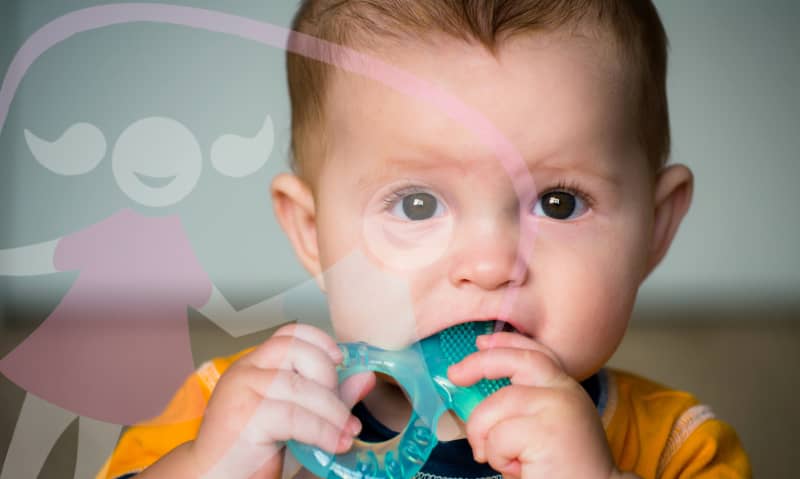Home Remedies for Baby Teething Symptoms

It’s so disheartening to see your baby teething. Those flushed cheeks and the endless drool, along with an irritable baby that can’t be soothed, isn’t just heartbreaking, it can be frustrating too. So when your baby is showing signs of teething, it is inevitable you want to bring them some comfort. Thankfully, there are some easy home remedies to soothe your baby’s teething symptoms.
When do babies start teething?
Before we get into how to bring that inconsolable teething baby some comfort, let’s make sure you’re in the know about teething babies. First, when does your baby start teething? And you’ve probably heard this answer to many of your baby questions—all babies are different. And when it comes to teething, that answer still holds true. But for most babies, teething starts around six months of age.
What are the signs and symptoms that my baby is teething?
Again, all babies are different. Some babies don’t show any signs or symptoms of teething at all, but most babies show some signs, especially when they are cutting that first tooth. Typical signs and symptoms of teething include:
- Swollen, tender gums.
- Fussiness and crying that isn’t consoled by normal means.
- Gnawing or chewing on hard or textured rags.
- Drooling.
- Rash on the face as a result of excess drooling.
- Coughing.
- Rubbing their cheek or pulling on their ear.
- Bringing their hands to their mouth frequently as though they are trying to touch the pain.
- Changes in eating or sleeping patterns.
What should I expect when my baby’s first tooth erupts?
Many parents, especially first-time parents, aren’t sure what to expect when their baby starts teething. The idea of a tooth cutting through the gums can be a bit daunting. It may be helpful to understand that your baby’s primary teeth are already present in their jaw at birth and will usually start to appear between six and 12 months of age.
Most kids will have all 20 primary teeth by age three. The first tooth to erupt is often the central incisor, located in the bottom front of the mouth. The next tooth is often the central incisor at the top of the mouth, followed by the lateral incisor at the top of the mouth. But again, this can be different for every child.
When your baby’s first teeth come in, their gums will be sore and swollen. Your baby will often find comfort in one of the homemade remedies suggested later in this article. But remember, if you have tried several home remedies and your baby just isn’t settling down, it is worth a call to your pediatric dentist or your child’s pediatrician.
In particular, be sure to call your pediatrician if your baby is showing signs of diarrhea, vomiting, rashes on the body, a high fever, or cough and congestion. These aren’t typical signs of teething.
How do I soothe a teething baby?
To help bring some comfort to your teething baby, try one of these simple baby teething remedies.
- Rub your baby’s gums with light pressure using a clean finger.
- Provide your baby with a cold spoon or chilled teething ring—do not soak the teething ring in fruit juices, as this can be bad for other teeth that may already be in your baby’s mouth. Stick to water.
- Try an over-the-counter remedy such as acetaminophen (Tylenol etc.) or ibuprofen (Advil, Motrin etc.). Be sure to follow dosage recommendations provided by the manufacturer or your pediatrician. Over-the-counter remedies are highly effective to help soothe a teething baby at night.
We also suggest that you avoid over-the-counter homeopathic teething tablets; teething medications containing benzocaine or lidocaine; and teething necklaces, bracelets, or anklets. These items either aren’t proven to be effective or can pose a risk of choking, strangulation, mouth injury, infection, or illness.
How do I care for my baby’s new teeth?
Taking care of your baby’s new teeth starts the day the first new tooth breaks through the gums. Start each day by running a clean and damp washcloth across your baby’s gums to clear away any bacteria that has built up overnight. You can also use an infant toothbrush if you have one. Repeat this process at bedtime. Be sure to also do the following.
- Use an infant toothbrush twice a day with a small amount of infant toothpaste. Your pediatric dentist should guide you on whether or not you should use a fluoride toothpaste.
- When your baby gets more than one tooth and they start to touch, start flossing between them daily, just as you do for yourself.
- And, once your baby is two, start teaching them how to spit out the saliva that accumulates in their mouth from brushing. Do not give them water to swish and spit as this can inadvertently cause them to swallow the toothpaste.
Has your baby cut their first tooth? Time for a pediatric dentist visit.
If your baby has cut their first tooth, it’s time to think about scheduling that first trip to the dentist. Most dentists recommend that you bring your child to the dentist for the first time as soon as their first tooth comes in or by age one, whichever comes first. And, if you live in the North Platte, Hastings, Grand Island, or Omaha areas, Pediatric Dental Specialists offers the best dentists for pediatrics. So, what are you waiting for? Request an appointment for you and your baby now.